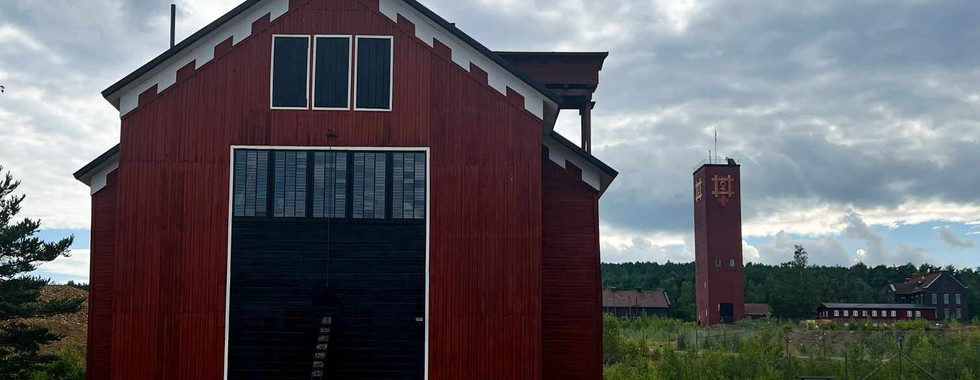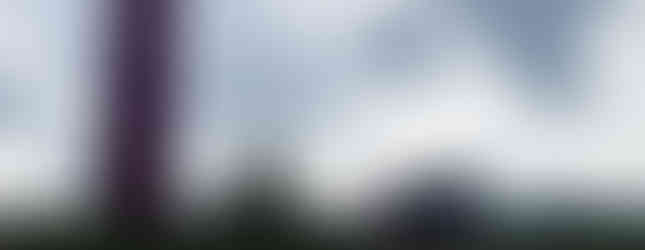(17)Day Seventeen: The Copper Mine and Red Houses - A Day in Falun
- Elflilja
- Sep 16, 2024
- 10 min read
Updated: Oct 6, 2024
The day started off quite leisurely—we weren’t in a hurry to go anywhere. In fact, we had breakfast on the terrace, which overlooked the riding stables and a forest. The view? Gorgeous. I couldn't imagine a more idyllic start to the day. Even the coffee tasted better while gazing at the lush green forest.
We might have enjoyed the peace a bit too long, as we left our excursion for the afternoon, which meant there was no time to visit both planned destinations. So, instead of Sundborn, we returned to Falun. We had visited the Dalarna Museum here the day before, but there was still more to explore.

First, we aimed for the famous Elsborg district. This isn't an ordinary place—Elsborg's history dates back to the 17th century, when Swedish copper mining was in its heyday. Of course, you won’t find miners swinging hammers anymore, but the historic atmosphere is palpable. The town of Falun, and especially Elsborg, was known for the Stora Kopparberget copper mine, which shaped life here for centuries. The narrow streets and the wooden houses painted in the classic Falun red offer a real journey back in time. No wonder this shade has become almost a national symbol of Sweden!
Elsborg was once the home of miners. Their lives weren’t easy, but the close-knit community was defined by mining. Today, this authentic district is a true tourist magnet and became a UNESCO World Heritage Site in 2001.
We just had to walk through the narrow streets for the old-time atmosphere to come alive. When we noticed on the map that the famous Falun Mine (Stora Kopparberget or Falu Gruva) wasn’t far, Petit was suddenly gripped by a spirit of exploration. I thought, why not? The day before, he had been quite patient while I admired kurbits paintings, folk furniture, and more Dala horses, so it was time for him to dive into something that piqued his interest. So, we headed to the mine, an important part of Dalarna's history. The famous Falun paint (Falu Rödfärg) gets its red pigment from this mine. We followed the designated path around the former mine, where the sulfurous smell and yellowish water streams, caused by mining minerals, were quite striking. The whole experience felt like more of an adventure. During the visit, we also got to see some preserved buildings from the mining era, like the Creutz Waterwheel House, which contains a water wheel and an elevator. The elevator house represents 19th-century technology and is the only surviving building of its kind in Sweden. The water wheel, which is top-driven, enabled the lifting and lowering of ore and other materials in the shafts.
After the mine, we wandered into the center of Falun because I wanted to stop by the Renbiten store in Falun. On the way, I spotted (what I believe is) the world's weirdest Dala horse in the window of an old red house. Perhaps it was trying to express femininity in a witchy way with a broom in its hand, although the half-female breast and genitalia carved on it were quite odd.
Returning to Renbiten, it's a shop selling traditional Sami goods, from reindeer meat to Sami jewelry and mugs—lots of interesting things. Near the main square, we saw a few more curiosities, like Viking graffiti riding a Dala horse, and a memorial statue of Engelbrekt Engelbrektsson in front of the church.
I documented a lot of information during the visit, which I'll share below, and there will also be a photo gallery at the bottom. :)
At the end of the day, we were just returning to our accommodation when we noticed that a retro car meet was taking place at the Falun sports hall (Lugnet). Of course, we couldn't miss it! The sight of those old cars was a fantastic way to end the day. Later that evening, we sat out on the terrace again, listening to the calm of the distant forests—and the howling of our host's dog. It was so wolf-like that, for a moment, we weren't sure—was it really just a dog?
So, that was our day in Falun—history, copper mines, and a dash of retro car romance.
Falu Gruva History, Falu Rödfärg Paint, Interesting Facts:
According to old legends, a goat named Kare discovered the ores in the Falun mine. Kare was grazing on the slope, and when it rubbed its horns on the ground, they turned red. Recognizing the value, its owner started digging. Soon, a rich copper ore vein was discovered, and the first mine was opened here. The place was named Bockbacken or Goat Slope. Legends about the goat and its owner are also linked to other mines, such as those in the Harz and Rammelsberg in Germany, and in Røros, Norway, where a reindeer supposedly found the copper.
The ores in the Falun mine were formed more than two billion years ago during intense volcanic eruptions. At that time, Scandinavia was located in the southern part of the Atlantic Ocean, and the minerals mixed with sand, which later remained in the form of quartzite, leptite, and mica schist. The mine contains more than 130 different minerals, and archaeologists have taken soil, sediment, and pollen samples to explore its rich history.
History: The Falun mine is located on the eastern slope of Gruvrisberget, where there was once a lake. The lake filled with sediment and turned into a marsh. Local farmers began mining ore here. As mining grew, a trading post was established by the river, which later developed into the town of Falun. By the 17th century, Falun had grown to become Sweden's second-largest town, with around 6,000 inhabitants.
The mine operated for thousands of years and was the largest employer in Europe in the 17th and 18th centuries, with up to 1,300 miners. The mine provided significant wealth for Sweden and contributed to the country's rise as a European power. At its peak, the Falun mine produced two-thirds of the copper in the Western world.
The town was built around mining, and by the end of the Middle Ages, Falun was larger than most cities in Sweden. In 1641, Falun received city rights, and the new town planning included Kristine Church, Store Torget square, and new straight streets. The miners were moved to a new district, Elsborg, while merchants and craftsmen settled in the town center. Falun's architectural style resembles the towns of northern Germany, with German names, and it is one of the largest wooden cities in Scandinavia. The Carl XVI Gustaf lookout tower was opened by the King himself in 2002. The tower features a sculpture representing the Falun World Heritage Site, created by Jörg Jeschke.
The mine was already operational in the eighth century. The earliest documents date from 1288 and 1347. The 1288 exchange letter confirms that Peter, the Bishop of Västerås, acquired a share of the mine, which was then called Tiskasjöberg. The mine's name has changed over the years and is most commonly known as Falun Mine or Stora Kopparberget.
In the 15th century, the mine masters wielded significant influence over the economy and politics of Dalarna and Sweden. In the 16th century, however, King Gustav I clashed with them, and the mine masters eventually lost their political power. In the 1570s, the technological advancement of mining contributed to the growing demand for copper in Europe. By the 17th century, the Falun mine was the largest copper producer in the Western world.
By the late 18th century, copper reserves had declined, and by the 19th century, the focus shifted to iron production and forestry products. In 1888, the mining company was transformed into Stora Kopparbergs Bergslags AB. By the 1980s, Stora was among the world's top ten forestry companies, and in 1992, mining ceased at the Falun mine. Since 1998, the company has been part of the Stora Enso group, and since 2000, the mine has been owned and managed by the Stiftelsen Stora Kopparberget foundation. In 2001, UNESCO listed the Falun mine as a World Heritage Site, including parts of the town and the mine masters' countryside.
Buildings:
Creutz Hoist House: The Creutz hoist house contains a water wheel and a hoist that operated iron wires to raise or lower ore, personnel, and construction materials in the mine. The building was designed by engineer Håkan Steffansson in 1855. After its reconstruction in 1875, the hoist remained in operation until 1916. It is the only surviving 19th-century hoist house in Sweden.
The building is divided into two parts: a dry section and a wet section. The water wheel is located in the wet section, while the hoist wheel is in the dry section. The water needed to operate the wheel was supplied through pipes from the mine’s southwestern lakes. Diagonal braces on both sides of the building provide lateral stability for the structure's heavy moving parts. The movement and direction of the water wheel were controlled by an elevator operator who worked in a hut located on the side of the wheel.
Water Wheel: The water wheel is top-driven, meaning it receives water from above. The wheel consists of an axle, two parallel wheel disks, spokes, a planked outer wheel disk, and buckets. Water was collected from a chute into a reservoir above the wheel. When the water flow was released, it ran through the pipes and struck the buckets on the wheel. The wheel made 3-4 revolutions per minute and could be reversed to rotate in different directions. To prevent the water wheel from freezing in winter, double walls were built, and grooves were made in the inner masonry to allow water to flow quickly into the wheel pit. The hoists powered by the water wheel were used by local farmers and miners during mining activities.
Falu Rödfärg: The pigment used for this paint comes from the ore mining at the Falun mine. The ore is hand-sorted, and the low-copper stones are placed in waste heaps. The iron oxide that gives the pigment its red color is formed during the decomposition of iron, pyrite, pyrrhotite, and chalcopyrite in the ore. When iron-containing minerals decompose, limonite forms, which is yellow or yellowish-brown. The production of the pigment is divided into two phases: the mixing and the firing phases. In the mixing phase, the raw material is mixed with water to wash the small, decomposed materials out of the stones. The finely ground material is pumped into a settling basin, where it settles over a few months, and the filtered water is drained. The material is dried, and after evaporating all the water, it is dried at around 150 degrees Celsius and then fired. The firing temperature gradually increases from 500 degrees to about 700 degrees Celsius, where the limonite transforms into iron oxide, giving the pigment its red color. Darker shades can be achieved by increasing the firing temperature, and at around 950 degrees Celsius, even a black shade can be produced. The process is tested every hour to ensure the pigment's proper shade, and at the end of the firing process, the material is prepared for refinement and storage.
Today, Falu Rödfärg is an ever-expanding range of products associated with the home. The original lime paint has been developed with new colors, and it is now available in red, bright red, gray, and black. It is also available in spray form for larger buildings such as agricultural structures. Falu Rödfärg Original is Sweden's most tried-and-tested house paint, but it has one limitation: it can only be painted on unpainted or lime-washed wood. A modern alternative has been developed for those who want the traditional, matte surface look but can paint on other materials. This is Falu Rödfärg Façade Paint, which combines the properties of modern facade paint with the appearance of traditional lime paint. The facade paints are complemented by Falu Rödfärg Knut&Foder paint, which is specifically designed to protect the most vulnerable wooden parts of houses.
Most paint brands are associated with paint, but when someone says "Falu Rödfärg," people think of things like summer, sunshine, grandma, strawberries, ice cream, or freedom. Falu Rödfärg affects millions of memories and feelings and creates new opportunities for positive experiences. Its roots lie in Swedish architectural traditions and cultural heritage. Behind the product carrying this brand is 250 years of "quiet knowledge" that covers everything: from handling the pigment to the quality of linseed oil that determines the paint's properties. Architects and those who live in Falu red houses associate a special feeling with the paint. It is a brand whose quality is determined by human senses and constantly evolves to meet modern needs while preserving traditional values.
Engelbrekt Engelbrektsson: (c. 1390 – May 4, 1436) was a Swedish nobleman, Sweden's military governor, a freedom fighter, and a national hero. He was the leader of the Engelbrekt Rebellion, which deposed King Eric VII, the ruler of the Kalmar Union. Engelbrekt Engelbrektsson was a nobleman and mine owner from Dalarna, closely connected to the miners in the region, who played a central role in his uprising.
Engelbrekt's family migrated from Germany in the 1360s and became mine owners in the Dalarna region. He was outraged by the way the Danish governor oppressed and overtaxed the miners, severely affecting the mining communities that formed the heart of the local economy. After the king dismissed Engelbrekt's complaints, he launched an open armed rebellion in 1434, which soon attracted not only miners and peasants but also the nobility and members of the Council of State. The rapid success of the rebellion demonstrated the strength of the Swedish people and Engelbrekt's charismatic leadership skills.
In 1435, Engelbrekt was elected the country's military governor at the Riksdag of Arboga, which is also significant as one of the earliest parliamentary events in Swedish history. Although the nobility and clergy later supported Karl Knutsson Bonde, Engelbrekt's central role remained unquestionable until 1436, when he was assassinated by an old enemy, Måns Bengtsson.
After his death, Engelbrekt Engelbrektsson was almost venerated as a saint, and pilgrimages were made to his tomb in Örebro, where miraculous healings were said to have occurred. Although the Reformation ended his religious cult, Engelbrekt became even more important on another level: he became a symbol of Swedish independence and resistance to foreign influence.
The statue of Engelbrekt Engelbrektsson in Falun is symbolically connected to the Swedish Viking heritage. While Engelbrekt himself was not a Viking, the Viking spirit—commitment to freedom, struggle, and independence—clearly appears in his figure. The parallel between the Engelbrekt Rebellion and the Viking's conquering past highlights Sweden's long historical struggles against foreign influence. Engelbrekt Engelbrektsson, as a national hero, perfectly fits into this tradition, and this statue is a symbol of Swedish freedom and self-determination. It is not only a memory of the past but also a part of the legacy of the Swedish national identity and the struggle for independence.







































































Comments